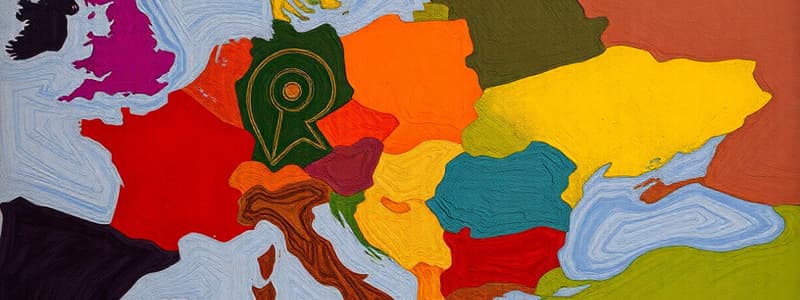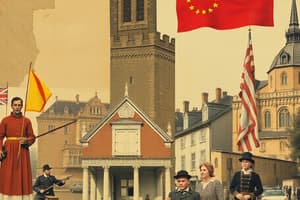Podcast
Questions and Answers
Which of the following best characterizes the primary shift in allegiance experienced by common people as feudalism declined?
Which of the following best characterizes the primary shift in allegiance experienced by common people as feudalism declined?
- From wealthy landowners to a shared national identity and sovereign government. (correct)
- From local lords to the Church, seeking spiritual guidance and stability.
- From agricultural labor to military service, defending national borders.
- From the king to elected representatives, as democratic ideals spread.
How did the growth of towns and cities contribute to the weakening of feudalism in Europe?
How did the growth of towns and cities contribute to the weakening of feudalism in Europe?
- By providing military support to feudal lords, consolidating their power against external threats.
- By establishing religious centers that rivaled the authority of local lords and the Church.
- By reinforcing the economic power of feudal lords through increased agricultural production.
- By creating centers of trade and attracting people seeking economic opportunities outside the feudal system. (correct)
Which factor contributed to the rise of trade routes in pre-1500s Europe?
Which factor contributed to the rise of trade routes in pre-1500s Europe?
- Increased isolation between the East and West.
- Decreased demand for Eastern goods.
- A decline in urban populations, necessitating new networks for food distribution.
- The Crusades, which exposed European soldiers to the wealth of the East. (correct)
Prior to the 1500s, what was the primary form of political and economic organization in Europe?
Prior to the 1500s, what was the primary form of political and economic organization in Europe?
Which of the following is the MOST accurate description of a nation-state?
Which of the following is the MOST accurate description of a nation-state?
Both Louis XI of France and Ivan IV of Russia utilized similar strategies to consolidate their power. Which common approach did they both employ to gain the support of the merchant class?
Both Louis XI of France and Ivan IV of Russia utilized similar strategies to consolidate their power. Which common approach did they both employ to gain the support of the merchant class?
Henry VII of England's reign is notable for strengthening the nation-state through trade. Which of the following best exemplifies his contribution to the English economy?
Henry VII of England's reign is notable for strengthening the nation-state through trade. Which of the following best exemplifies his contribution to the English economy?
The Act of Supremacy in England and the Pragmatic Sanction of Bourges in France, though distinct, both reflect a broader trend in 15th-century Europe. What common outcome did these royal decrees aim to achieve?
The Act of Supremacy in England and the Pragmatic Sanction of Bourges in France, though distinct, both reflect a broader trend in 15th-century Europe. What common outcome did these royal decrees aim to achieve?
Ferdinand and Isabella of Spain utilized Catholicism to unify their nation, a different approach compared to England and France. How did they primarily employ religious unity to strengthen Spain?
Ferdinand and Isabella of Spain utilized Catholicism to unify their nation, a different approach compared to England and France. How did they primarily employ religious unity to strengthen Spain?
The decline of feudalism and the diminishing power of the Church were critical factors in the emergence of modern nation-states. Which of the following best describes the relationship between these shifts and the rise of monarchies?
The decline of feudalism and the diminishing power of the Church were critical factors in the emergence of modern nation-states. Which of the following best describes the relationship between these shifts and the rise of monarchies?
Flashcards
Nationality Before 1500s
Nationality Before 1500s
Before the 1500s, the concept of distinct nations was not as defined as it is today.
Nation-State
Nation-State
A defined territory with a sovereign government, sharing a common culture, history, and language. A nation or country.
Feudalism
Feudalism
A political and economic system based on land ownership where most people lived on land owned by a wealthy nobleman.
Rise of Trade Routes
Rise of Trade Routes
Signup and view all the flashcards
Decline of Feudalism
Decline of Feudalism
Signup and view all the flashcards
Louis XI
Louis XI
Signup and view all the flashcards
Henry VII
Henry VII
Signup and view all the flashcards
Ivan the Terrible
Ivan the Terrible
Signup and view all the flashcards
Act of Supremacy (1534)
Act of Supremacy (1534)
Signup and view all the flashcards
Ferdinand and Isabella
Ferdinand and Isabella
Signup and view all the flashcards
Study Notes
- Prior to the 1500s, the concept of nations and nationalities was not widely understood.
- Before the 1500s, concrete nations or nation-states did not exist.
- Two factors that led to the rise of nation-states include the decline of feudalism and the decline of Church power.
- A nation-state is a defined territory with a sovereign government, comprising people who share a common culture, history, and language.
- The medieval period of Europe, from the 5th to the 15th century, was characterized by feudalism.
- Feudalism is a political and economic system based on land ownership.
- Under feudalism, most people lived on land owned by a wealthy nobleman, with allegiance to the landowner rather than a country.
Decline of Feudalism
- The development of trade routes led to the creation of new towns and cities.
- After the Crusades, European soldiers returned with tales of the wealthy East, leading to trade routes and the development of towns.
- Towns demanded independence from local lords and became beacons of freedom for poor workers.
- The poorer classes seized the opportunity to become free merchants and craftsmen in these new towns.
- As towns grew, feudalism's grip began to weaken.
- European monarchs consolidated power by allying with the growing merchant class as feudal lords lost their grip.
- Louis XI of France (1461-1483) allied with the merchant class by encouraging trade through infrastructure development.
- Louis XI imposed taxes to finance improvements, which people accepted in exchange for stability from a strong king.
- Louis XI is considered one of the first modern kings of France, unifying the country.
- Henry VII of England's Tudor dynasty encouraged trade through infrastructure improvements and trade agreements.
- The Intercursus Magnus of 1496 gave England a strong hold on the European wool trade.
- By the end of Henry VII's reign in 1509, England was a prosperous nation unified under the Tudor dynasty.
- Ivan IV of Russia (Czar in 1547) waged war against the nobility to consolidate power and gained the loyalty of the merchant class by giving them positions in new state bureaucracies.
- Russia emerged as a strong, centralized nation under Ivan IV.
Church Power Declines
- 15th century Europe experienced significant changes in the power of the Church.
- England's 1534 Act of Supremacy, where King Henry VIII declared himself the Supreme Head of the Church of England.
- The Act of Supremacy gave people a sense of national pride, as they were no longer controlled by the Church.
- In 1438, King Charles VII of France unveiled the Pragmatic Sanction of Bourges.
- The Pragmatic Sanction of Bourges gave more power to the monarchy and increased national sentiment by removing the Pope as the ultimate authority over the French Church.
- Ferdinand and Isabella of Spain rallied their people to remove Muslim influence, unifying Spain.
- Spain became a unified nation, giving allegiance to their king and queen, although respecting the Pope and the Church.
- Monarchs made their nations global powers with defined boundaries and strong centralized governments.
Studying That Suits You
Use AI to generate personalized quizzes and flashcards to suit your learning preferences.



